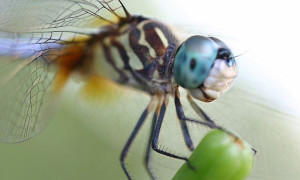Dragonfly Eyes
“In the beginning of all things, wisdom and knowledge were with the animals, for Tirawa, the One Above, did not speak directly to man. He sent certain animals to tell men that he showed himself through the beast, and that from them, and from the stars and the sun and moon should man learn . . . .”
-Chief Gray Eagle
 The Bear River Range in Cache Valley feeds its lowlands with rivers, including the Logan, Little Bear, and Blacksmith Fork. Rivers are unique in a mostly arid Utah. I like to think they can teach us about life. They are great examples of disturbance-dependent ecosystems—places that require periodic adversity (even violence, like flooding events) to be healthy and thrive. Rivers are also referenced in mindfulness teachings. Breath can be viewed as flowing like a river. Also, life is like a river—you never step in the same thing twice because it’s constantly changing.
The Bear River Range in Cache Valley feeds its lowlands with rivers, including the Logan, Little Bear, and Blacksmith Fork. Rivers are unique in a mostly arid Utah. I like to think they can teach us about life. They are great examples of disturbance-dependent ecosystems—places that require periodic adversity (even violence, like flooding events) to be healthy and thrive. Rivers are also referenced in mindfulness teachings. Breath can be viewed as flowing like a river. Also, life is like a river—you never step in the same thing twice because it’s constantly changing.
Logan is snow-covered now, readying next season’s rivers. Even so, I think of one of my favorite warm weather water friends—a dragonfly. Dragonflies are of the order Odontata. They are fearsome predatory insects that hunt on the wing, eating up to one-fifth of their body weight each day. Dragonflies are some of the insect world’s most efficient hunters, catching 95% of the prey they pursue. The Pueblo, Hopi, and Zuni associated dragonflies with transformation. In Japan, they are symbols of rebirth, courage, strength, and happiness. I like Aeshna, the mosaic darner.
This brings us to dragonfly eyes. In the book Super Forecasting, The Art and Science of Prediction, Philip Tetlock and Dan Gardner detail evidence-based attributes of people who are especially good at thinking, and at forecasting in particular. They find that those best equipped for this skill “deploy not one analytical idea but many and seek out information not from one source but many. Then they synthesize it all into a single conclusion. In a word, they aggregate. . . . And there is no reason to stop at three or four perspectives . . . a fourth, fifth, and sixth perspective can further sharpen a judgment. In theory, there is no limit. . . . [T]he best metaphor for this process is the vision of the dragonfly.”
Each dragonfly eye is comprised of up to thirty thousand lenses, each covering a space slightly different from another, giving each lens a unique perspective. Within the dragonfly brain, these perspectives are all “synthesized into vision so superb that the dragonfly can see in almost every direction simultaneously, with the clarity and precision it needs to pick off flying insects at high speed.”
Tetlock and Gardner explain that the skill of aggregating perspectives to arrive at a more accurate truth is not something that comes naturally to us. I don’t think it’s really popular either. But, the alternative—using only one perspective—does not improve foresight; rather, it distorts it by creating increased confidence and inferior accuracy—a bad combination.
So, may we all step outside of ourselves, do the hard work of consulting other perspectives, and get a different view of reality in our truth seeking. Eye of the dragonfly.
